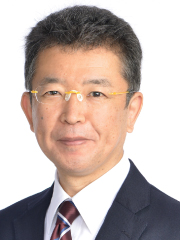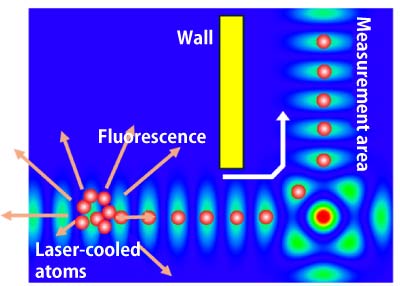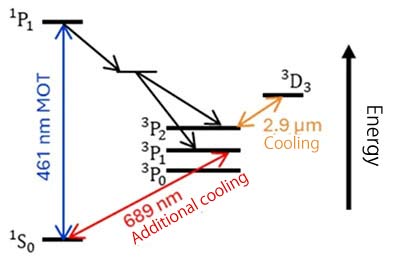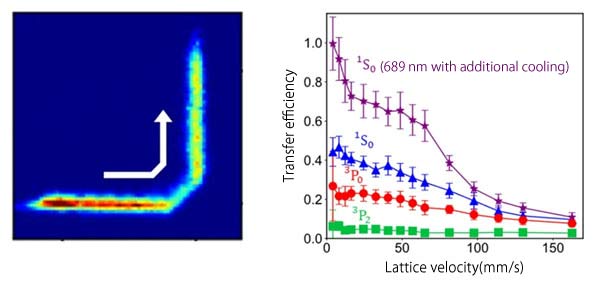Research Results
Development of a Continuous Atomic Source Essential for High Precision in Optical Lattice Clocks
Using a Crossing Optical Belt Conveyor to Change the Direction of Atomic Motion for TransportationFY2025

- KATORI Hidetoshi (Professor, Graduate School of Engineering, The University of Tokyo)
- JST-Mirai Program
- Program Manager (2018-2027), Large-scale Type: "Space-Time Information Platform with a Cloud of Optical Lattice Clocks"
World's first continuous atom source that simultaneously performs laser cooling and quantum measurement
A research team represented by Professor Hidetoshi Katori at the Graduate School of Engineering, The University of Tokyo developed the world's first continuous atom source which extracts laser-cooled atoms by an optical belt conveyor and further outputs by transferring the atoms onto a crossing optical belt conveyor. This technology is anticipated to further improve the accuracy of the optical lattice clock invented by Professor Katori in 2001 and contribute to innovative technologies such as next-generation communication systems and high-precision positioning systems that can replace the global navigation satellite system (GNSS).
The laser cooling method is a method for ultracold atom generation that is indispensable for quantum measurement in quantum sensing and quantum computing. However, laser cooling and quantum measurement could not be performed simultaneously because light generated during the cooling process disrupts the quantum state of atoms. The research team developed a technology that uses moving optical lattice*1, which functions as a belt conveyor for atoms, to draw out laser-cooled ultracold strontium atoms, and then transfers the atoms to a second optical belt conveyor to transport them in an orthogonal direction. This allows the blocking of only the light generated in the laser cooling area using screens and thereby the continued high-precision quantum measurement in the second optical belt conveyor area (Fig. 1). The technology enables implementation of a high-precision quantum measurement called "zero dead-time measurement*2" and will lead to a dramatic improvement in the accuracy of optical lattice clocks*3.

Fig.1 Schematic Diagram of the Experiment Atoms that are laser-cooled on the first belt conveyor are extracted to the right and are transported upward on the second belt conveyor (a white arrow indicates the direction of atomic motion). Atoms on the second belt conveyor are not affected by the light generated from laser cooling, allowing highly accurate quantum measurement.
*1 Moving optical lattice
When two laser beams of equal frequency (wavelength) are in the opposite direction of each other, the laser lights interfere with one another and produce standing waves (waves whose waveforms appear to be stationary and oscillating in place). In a standing wave, a "belly" showing maximum optical intensity and a "node" showing minimum optical intensity form at every half wavelength. When the frequency of the laser light is made lower than the resonance frequency of atoms, an optical lattice that periodically confines the atoms is formed at the belly position of the standing wave. Subsequently, when the two laser lights are made to slightly differ in frequency, the belly position of the standing wave moves at a speed proportional to the difference in frequency. This allows atoms trapped in the optical lattice to move.
*2 Zero dead-time measurement
If the duration of measurement is Δt, the accuracy of frequency measurement, Δν, improves by Δν = 1/Δt. By comparing the frequency of the laser light with the resonance frequency of the atoms over a long Δt, the frequency of the laser can be measured with higher precision.
*3 Optical lattice clock
A method of atomic clocks that references a large number of atoms captured in an optical lattice with a special wavelength known as the "magic wavelength*4" and meets high-precision standards on optical frequency.
*4 Magic wavelength
When atoms are confined using laser light of a specific wavelength, the frequency of light absorbed by the atoms is not affected by the confinement. Such wavelengths are called "magic wavelengths."
"Continuous atomic source" essential for high precision, small size, and light weight in optical lattice clocks
The optical lattice clock was invented by Professor Katori in 2001 and has been supported by JST's PRESTO, CREST, ERATO, and JST-Mirai Program since 2002. Since then, the accuracy of the optical lattice clock has reached 18 decimal places (as of 2014), which is equivalent to approximately 1000 times that of the currently most accurate cesium atomic clock. With such accuracy, the optical lattice clock is off by only 1 second in 30 billion years.
A technology critical to further improving the accuracy of this optical lattice clock is the development of a "continuous atomic source." Laser-cooled ultracold atoms confined in an optical lattice have a long coherence time*5 due to the suppression of the Doppler effect*6 arising from the thermal motion of atoms and thus play an important role in the field of quantum measurement such as optical lattice clocks. However, light generated in the laser cooling process disrupts the quantum state of the atoms being measured, posing difficulty in simultaneously performing laser cooling and quantum measurement.
For this reason, laser cooling and quantum measurement operations have been separated in terms of timing, and measurements have been made by repeating the two operations alternately. That is to say, time spent on laser cooling was "dead-time" and therefore hindered the enhancement in precision. Enabling "zero dead-time measurement," where observations and measurements are performed without any "dead-time” in between, may dramatically improve accuracy in quantum measurement.
*5 Coherence time
The time during which a quantum state can evolve over time without disruption is called coherence time. When subjected to disruption from the surrounding environment, the coherence time shortens, and the accuracy of quantum measurement diminishes.
*6 Doppler effect
When a moving object approaches (or distances from) a wave source, the frequency of the vibration is observed to be higher (or lower). This change in frequency arising from the motion of objects is the Doppler effect. Because atoms demonstrate varying velocities due to thermal motion, the spectrum is broadened due to the Doppler effect and spectral accuracy decreases. Laser cooling can reduce the Doppler effect but not completely eliminate the effect. Optical lattice clocks eliminate it by capturing atoms in an optical lattice and quantizing (discretizing) the motion of the atoms.
Realizing "zero dead-time measurement" by developing "continuous atomic source"
The development of a continuous atom source addressed in the present research, which outputs laser-cooled atoms by transferring them on two crossing optical belt conveyors, is a technological element that is vital to enabling "zero dead-time measurement."
Fig. 2 shows the experimental setup. In the first step, strontium atoms are laser-cooled to about 1 mK using magneto-optical trapping in a large anisotropic quadrupole magnetic field created by a bar magnet and others. While repeating this cooling cycle, the atoms enter a metastable state with a lifetime of approximately 100 seconds. Since atoms in this state have magnetic moment, they are trapped by the quadrupole magnetic field (Fig. 3).
In the second step, the atoms are further cooled with laser light to about 10 μK and captured in an optical lattice. This two-step cooling allows the thermal atoms to be continually cooled and captured in the optical lattice.
The present research succeeded in changing the direction of atomic motion by using moving optical lattice as atom belt conveyor to continually extract laser-cooled ultracold atoms and transferring the atoms onto a crossing moving optical lattice. Fig. 4 (left) shows how ultracold atoms transported from the laser cooling area are transferred onto an orthogonal moving optical lattice and change the direction of their motion. In this crossing region, atoms are observed to move by being captured by a moving optical lattice that moves at a 45-degree angle, which is formed by the interference of orthogonal moving optical lattices.
For atoms captured by such moving optical lattice, the longitudinal excitation spectroscopy method which implements laser from the direction the atoms travel and performs atomic spectroscopy as well as a method for improving optical lattice clock accuracy through "zero dead-time measurement control" using the longitudinal excitation spectroscopy method have been proposed. The results of this research provide an important technological basis for implementing this longitudinal excitation spectroscopy method to achieve high precision, small size, light weight, and stable operation in optical lattice clocks.

Fig.2 Experiment Setup Atoms are laser-cooled and magneto-optical trapped in a large anisotropic quadrupole magnetic field created by a bar magnet and others. During this magneto-optical trapping process, the atoms relax to a metastable state with magnetic moment and are thus magnetically trapped by the quadrupole magnetic field. In this magnetic trap, atoms are laser-cooled with narrow linewidth transition. The atoms move downward by approximately 5 mm due to gravity and the radiation pressure of the laser cooling light. The atoms were drawn out by a moving optical lattice and further, placed on a crossing moving optical lattice to change the direction of motion.

Fig.3 Energy Level Diagram of Strontium Transition (wavelength of 461 nm) from the ground state (1S0) is used for magneto-optically trapping. When light absorption and emission are repeated for approximately 100,000 cycles, the atoms relax to a metastable state and are magnetically trapped. The atoms are further laser-cooled (wavelength of 2.9 µm) and captured in an optical lattice.

Fig.4 Ultracold Atoms That are Transported and Change in Motion Direction by a Moving Optical Lattice (left), and Dependency on Velocity and Electronic State in Migration Efficiency Between Orthogonal Moving Optical Lattices (right) The graph on the right shows the dependency on velocity in the migration efficiency of atoms between the two moving optical lattices. The lower the moving speed, the more efficient the migration. In particular, laser cooling at the crossing area improved migration efficiency to nearly 100%.
Commercialization of optical lattice clock in as early as FY2025
A commercial-use device of the optical lattice clock will be marketed in FY2025 as of plan. By installing the device at multiple locations on the earth and establishing distribution technologies that can share time over long distances in order to provide an ultra-high-precision time infrastructure to society at large, the device will likely come to be used in next-generation communication systems and high-precision positioning systems that replace the global positioning system (GPS). In fact, in 2022, the National Institute of Information and Communications Technology succeeded in generating standard time using an optical lattice clock. Optical lattice clocks are also identified as a strong candidate for changing the definition of one second, which the International Committee of Weights and Measures plans to achieve by 2030.
The research results are anticipated to lead to further improving the accuracy of such optical lattice clocks for future social implementation.
